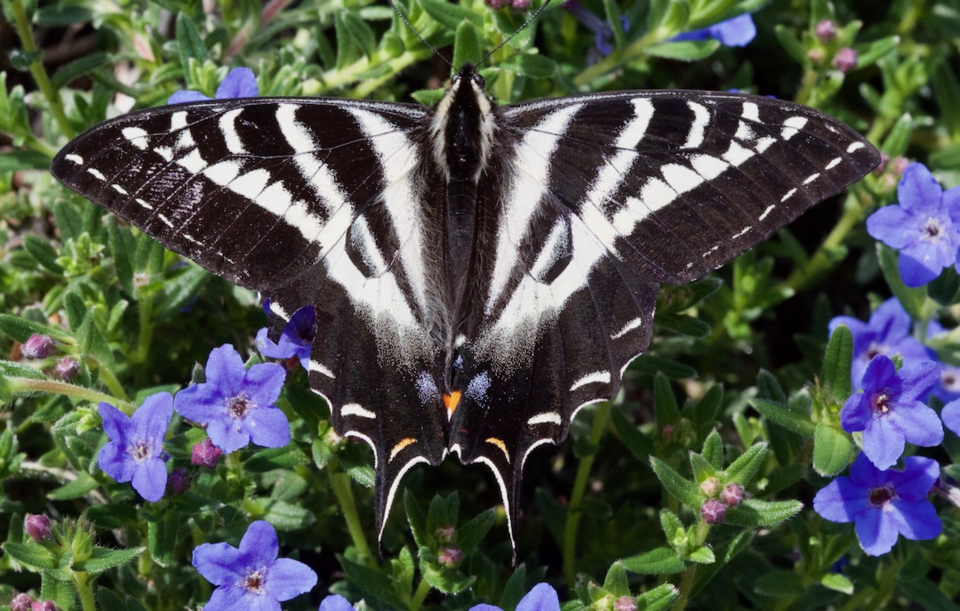Not all gardens are created alike. Just ask any butterfly.
Butterflies have a long natural history on Earth. Scientists have discovered butterfly fossils dating back 40 million years and one of the most marvelous wonders in nature is the butterfly transformation from caterpillar to pupa.
Caterpillars hatch from eggs laid by an adult butterfly. The eggs are tiny and unremarkable. When they hatch the baby caterpillars are very hungry, small and defenseless. They begin their feast by eating their egg casing then start chewing on leaves of host plants, like red flowering currant.
Rand Rudland, one of the authors of Butterflies of the Sunshine Coast, comments: “Pesticides, habitat loss and climate change are driving precipitous declines in pollinator insect numbers, all driven by population growth on this crowded Earth that we are increasingly unwilling to share with nature.
“The one area where we can assist pollinator recovery is by doing our little bit to reverse habitat loss, by planting shrubs, flowers, and trees known to be used by our main pollinators – bees and butterflies. Whether on your balcony or deck or reclaiming some of your lawn to grow native plants, or converting a patch of invasive blackberries to a dedicated butterfly garden, if enough Sunshine Coast residents made decisions to support our native plant biodiversity the benefits to pollinator insects could be significant. Not to mention the benefits of spending more healthy outdoor time with family and friends.”
With pollinators in serious decline, it is more important than ever to take part in their conservation. One of the most rewarding ways to do this is by creating a butterfly garden oasis.
In order to attract butterflies, think and see like a butterfly.
Butterfly expert Rachel Diaz-Bastin, of the Conservatory of Flowers in San Francisco sheds light on this topic when she says, “If we were to see like a butterfly, we would look at really bright colours, red, yellow, and blue, because those are the flowers that are really bright and advertise that they have sugary water and good nectar for them to drink.”
Pick a sunny spot. Provide food.
Butterflies love sunshine and an easy place to land. Select an area protected from the wind, with big and small rocks to rest and warm up in early morning sunshine. Butterflies also like mud or puddles and a place to hide from predators, like a loose log pile.
Make a list of native host and nectar plants for butterflies. Provide three season bloom plants, with different heights planted in clumps of three to five plants. Butterflies love plants with flat topped shapes, flower spikes with lots of tiny flowers and cone type. Choose a mix of trees, shrubs, bulbs, herbs, perennials, and annuals.
Go native whenever possible! Go organic. Don’t use chemical fertilizers or pesticides, as they can harm butterflies and other wildlife.
In honour of this year’s Earth Day theme, April 22, “Invest In Our Planet! What Will You Do?” the Sechelt Garden Club, in partnership with The District of Sechelt Parks Department, will undertake the planting of a huge Butterfly Garden at Cascade Green Park located in West Sechelt. The garden will create a colourful, fragrant bounty for birds, bees, butterflies and beneficial insects.
Community members and park users will once again engage in an organized community event that will benefit our butterfly and pollinator populations, provide an opportunity to meet like-minded individuals, enjoy some fresh air and get physical exercise.
If you would like to contribute; $20 will buy five butterfly plants, $40 will buy the plants, soil, and mulch. Please make cheques payable to Sechelt Garden Club, P.O. Box 1492, Sechelt, BC, VON 3A0 or by etransfer to [email protected]. If you would like to volunteer, plant a plant, grow a plant or donate a plant please send a note to [email protected]
Find more information at secheltgardenclub.com and inaturalist.org/projects/butterflies-of-the-sunshine-coast-bc-canada.




